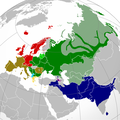Fil:Indo-European branches map.png

Storlek på förhandsvisningen: 599 × 600 pixlar. Andra upplösningar: 240 × 240 pixlar | 479 × 480 pixlar | 767 × 768 pixlar | 1 023 × 1 024 pixlar | 2 045 × 2 048 pixlar | 2 934 × 2 938 pixlar.
Originalfil (2 934 × 2 938 pixlar, filstorlek: 2,16 Mbyte, MIME-typ: image/png)
Filhistorik
Klicka på ett datum/klockslag för att se filen som den såg ut då.
| Datum/Tid | Miniatyrbild | Dimensioner | Användare | Kommentar | |
|---|---|---|---|---|---|
| nuvarande | 26 september 2022 kl. 05.43 |  | 2 934 × 2 938 (2,16 Mbyte) | Alexikoua | minor fixes |
| 30 mars 2022 kl. 17.58 |  | 2 934 × 2 938 (1,74 Mbyte) | Whoop whoop pull up | Whoops, wrong file! | |
| 30 mars 2022 kl. 17.37 |  | 2 048 × 2 048 (980 kbyte) | Whoop whoop pull up | Misc fixes (Russian minority in Svalbard & Israel, Slovenian in SE Carinthia, Greek in N Epirus, Aromanians/Megleno-Romanians, Swedish essentially extinct in Estonia, etc. | |
| 22 december 2021 kl. 11.37 |  | 2 934 × 2 938 (1,74 Mbyte) | Ahmet Q. | Reverted to version as of 19:55, 23 August 2021 (UTC)seek consensus for your changes | |
| 25 november 2021 kl. 22.40 |  | 2 934 × 2 938 (2,16 Mbyte) | Alexikoua | rv elimination of Greek minority in Albania | |
| 23 augusti 2021 kl. 21.55 |  | 2 934 × 2 938 (1,74 Mbyte) | Ahmet Q. | Rv false edit summary. Overrepresentation of Greeks in Turkey, Albania and Ukraine. Unexplained removal of Romanian in Serbia. Overall deterioration of the original file. Seek consensus for your changes. | |
| 7 augusti 2021 kl. 18.16 |  | 2 934 × 2 938 (2,16 Mbyte) | Demetrios1993 | Addition of Arbereshe linguistic minority in Sicily. Addition of Serbian, Bosnian, and Gorani linguistic minorities in Kosovo. Addition of Greek linguistic minorities in Italy, Albania, Turkey, and Ukraine. Including some other minor corrections. | |
| 19 november 2020 kl. 19.00 |  | 2 934 × 2 938 (1,74 Mbyte) | Golden | update Armenian | |
| 31 mars 2018 kl. 20.42 |  | 1 479 × 1 479 (574 kbyte) | Maphobbyist | Removed area that exactly corresponds to the non-Indo European Lezgi linguistic area. | |
| 6 september 2016 kl. 23.37 |  | 1 479 × 1 479 (620 kbyte) | Rob984 | Georgia and Azerbaijan aren't majority multilingual. Older generations speak Russian from the Soviet era but now English is taught mainly in place of Russian. More people speak English in Finland, yet that isn't coloured. Also corrections to Celtic are... |
Filanvändning
Följande 4 sidor använder den här filen:
Global filanvändning
Följande andra wikier använder denna fil:
- Användande på ast.wikipedia.org
- Användande på ban.wikipedia.org
- Användande på be-tarask.wikipedia.org
- Användande på be.wikipedia.org
- Användande på bg.wikipedia.org
- Användande på cs.wikipedia.org
- Användande på da.wikipedia.org
- Användande på de.wikipedia.org
- Användande på en.wikipedia.org
- Användande på en.wikiversity.org
- Användande på es.wikipedia.org
- Användande på et.wikipedia.org
- Användande på eu.wikipedia.org
- Användande på fa.wikipedia.org
- Användande på fi.wikipedia.org
- Användande på frr.wikipedia.org
- Användande på fr.wikipedia.org
- Användande på gl.wikipedia.org
- Användande på gu.wikipedia.org
- Användande på gv.wikipedia.org
- Användande på hak.wikipedia.org
- Användande på he.wikipedia.org
- Användande på hy.wikipedia.org
- Användande på hyw.wikipedia.org
- Användande på ilo.wikipedia.org
- Användande på incubator.wikimedia.org
- Användande på io.wikipedia.org
Visa mer globalt användande av denna fil.


